This LP is a collection of some of the 78rpm records by one of the greatest and most influential singers of last century. See below for his biography.
Ustad Abdul Karim Khan
by Smt. Susheela Misra
(From: "Great Masters of
Hindustani Music" by Smt. Susheela Misra.)
In the early decades of
this century, Khan Saheb Abdul Karim Khan dominated the world of Hindustani
music for well over a generation, and he was a trend setter in this world in
more than one sense. He created a new style or gharaana and gave an elan to the
history of Hindustani music. He has been acclaimed as the "maestro who
conceived, evolved, and popularised the Kirana gharana", and in fact, he changed
the entire mood of Khayal and Thumri-singing. Dr. S.N. Ratanjankar wrote to me
once about him: "In the late Ustad Abdul Karim Khan Saheb's sweet, tender, and
tuneful voice, the Hindustani melodies appeared in a role and mood quite
different from those in which they presented themselves in other voices...It was
like a walk in a cool, moon-lit garden of sweet-smelling flowers that one felt
when listening to the perfectly tuneful, and dreamy cadences of Khan Saheb's
music One was lifted up into a dream land. The dream haunted the mind long after
the music had ceased. The Khan Saheb never sang a raga, but was in holy
communion with it. It was the very divine world, as it were, which made you
forget the opposites, and led you to the perfect unity with the Supreme
spirit".
Those who have been able to hear the Ustad's music only through his
gramophone records, become aware of many shortcomings in his style such as the
nasal twang in the voice produced through "a deliberately constricted throat",
lack of bol-alaaps, bol-tans, rhythmic play, variety and grandeur. But, his
contemporaries who had the good fortune to hear him in person were completely
hypnotised by the sweetness of his music and his aesthetic emotion-filled
rendering of ragas. Late Prof. D.P. Mukherji who was a reputed music
connoisseur, wrote: "Abdul Karim Khan would invite us to enter into the sanctum
of music where he was the high priest. He was not an orthodox singer. He would
not even sing a composition through. His asthayi was not always true to form. He
would make unexpected permutations and combinations. . . . . , But who cared
when Abdul Karim Khan was on the dais ! This unorthodox man was a genius.
...Some of the finest exponents of Khayal today are either his pupils or his
pupil`s pupils. "
His shishya-parampura includes a long array of celebrities
such as Sawai Gandharva, Baharebuwa, Sureshbabu Mane, Balakrishnabuwa
Kapileswari, Dasarathbuwa Muley, Roshanara Begum; Hirabai Barodekar and many
others who in their turn, have groomed another generation of reputed singers
like Bhimsen Joshi, Feroz Dastur,Gangubai Hangal, Manik Verma, Saraswati Rane,
Prabha Atre and others.
Abdul Karim Khan was born in 1872 in Kirana near
Kurukshetra in the Punjab. Subsequently the style or Gharana that he evolved was
named after his birth place, Kiraana. In his perceptive book, "Indian Musical
Traditions", Sri Vamanrao Deshpande rightly says that "each gharana has its
origin in the distinctive quality of the voice of its founder and it is this
quality which broadly determines his style." To this I would also add that the
temperament of the founder also plays a considerable role in moulding the style
of the gharana.
Abdul Karim Khan was perhaps the first North Indian musician
to study Karnatic ragas and incorporate several of them into Hindustani music.
His records of songs in "Kharaharapriya", "Saaweri", "Hamsadhwani", "Abhogi"
etc. as well as his style of sargam-singing are proofs of his great admiration
and love for Karnatic music. Perhaps no single classical musician in those days
did so much for the promotion of mutual understanding between Hindustani and
Karnatic music as the late Khan Saheb did. The greatest quality of his music was
"emotion par excellence", and that was the reason why his classical music was
able to move audiences everywhere, whether in the North or South of India. I
know of many young men and women in South India who took to Hindustani music,
charmed by the spell of Khan Saheb's music. The ecstatic tributes of a
discerning western musician and critic after hearing the Ustad, prove how really
exalted music overleaps all barriers and transports listeners into a
transcendental world.
The critic writes: "I heard him melt half and quarter
tones into one another with the effect of magic--- He was a conjurer of
sounds...Who that has heard him can forget him. . . ! He not only sang sounds
but he became every turn and twist in the song. The atmosphere became surcharged
with a musical magic I have contacted nowhere else!".
The Kirana musical
lineage came mostly from instrumentalists--chiefly Sarangiyas. After receiving
his training from Kale Khan and Abdulla Khan, Khan Saheb went over to Baroda
where he was appointed as a court-musician because of his great merit. After
some years, he left Baroda for Bombay, and then went to Miraj. Wherever he went,
his sweet voice and captivating style of singing won for him numerous admirers.
From there, he proceeded to Hubli and Dharwar and stayed with his brother Abdul
Haq. The two brothers often used to sing together. A notable pupil he acquired
at this time was Rambhau or Sawai Gandharwa who later on, became one of his best
disciples by sheer dint of practice. The Ustad was very punctilious about his
early-morning daily practice, and Rambhau unfailingly practised with his
conscientious guru every morning. A true "pilgrim of melody engaged in his
eternal quest of swaras", Khan Saheb was constantly on the move. When he went to
Patna, Roshanara's mother became his pupil.
In 1913 Abdul Karim Khan founded
the Arya Sangeet Vidyalaya in Poona. It was a unique institution because the
Ustad not only imparted whole-hearted musical training, but himself supported
numerous poor and deserving students, took them on tours to give musical variety
shows, and trained them up to play on various musical instruments. The ustad was
an expert on many musical instruments, especially the Veena and the Sarangi. An
expert in repairing musical instruments, he carried with him his set of tools
for repairs everywhere because tuning the Tanpuras and perfecting their
"Jawaaris" was almost an art in itself with him. The famous Sitar and Tanpura
makers of Miraj revered him and looked up to his opinions for guidance.
A
branch of this magnanimous institution was founded in Bombay in 1917, but it
throve for only 2 or 3 years. When the School had to be closed down, Khan Saheb
migrated to Miraj where he built a house of his own, and settled down at last.
Though Miraj became the centre of his activities, he continued his musical tours
all over the North and even into the far South. During his stay in Hyderabad and
the Madras Presidency, his list of admirers and disciples in South India swelled
and his popularity grew so much that whichever town he visited, people garlanded
him and took him in a grand procession like a king. The ustad was greatly drawn
to the music loving people of the South, and he was one of the early Hindustani
musicians to kindle a great love for Hindustani music in the people of the
South. He had, and still has, hundreds of admirers in the South. In spite of all
the fame and adulation that he received, Abdul Karim Khan always lived frugally
like a Sadhu, and like the Rishis of yore, Khan Saheb trained his disciples
under the Gurukula system. He not only trained them thoroughly in music, but
also bore the entire cost for feeding and clothing them out of his own earnings
from concerts! Though a devout Muslim, and a devotee of Pir Sayyid Shamma Mira,
a mystic saint (whose dargah is famous in Miraj), Khan Saheb was, like Kabir, a
devout Hindu too, it is said. In his musical works he used to write '"OM TATSAT
SAMAVEDAYA NAMAHA". Although born in a musical Muslim family (on 1lth Nov.1872),
Abdul Karim took pride in his Hindu ancestors like Nayak DHONDU, a
court-musician of Raja Man Singh of Gwalior (1486-1516 A.D). His first public
concert was at the age of 11 (in 1893). Besides being such a great vocalist,
Khan Saheb had also an amazing mastery over such varied instruments as Been,
Sarangi, Jaltarang and Tabla. In Maharashtra great men like Lokamanya Tilak and
Gopalakrishna Gokhale were drawn to his music. In the South, he became a
favourite musician in the Mysore darbar, and his music was highly appreciated by
great Karnatak musicians like Tiger Varadacharier, Muthiah Bhagawatar and Veena
Dhanammal. He also created a stir by advancing the "Shruti Samvad" theory in
collaboration with the British musicologist Mr. E. Clements, and is said to bave
given a fine demonstration of 22 Shrutis (micro-tonal distances) with the help
of 2 Veenas at a public function' presided over by Dr. C.V. Raman.
One of the
most melodious classical musicians we have had, Abdul Karim Khan's music always
created a sublime atmosphere. The soothing quality of his specially cultivated
voice, and his reposeful style of singing were such that the singer as well as
his listeners forgot themselves in a sort of "trance". Many of his musical heirs
have surpassed him in technical virtuosity, but few have achieved "that degree
of hypnotic effect" through music. Not only did he develop his own "Kirana"
style of Khayal-badhut, but in his voice even the Thumri "shed its gossamer
erotic undertones" and assumed instead "the character of a sad, pensive, and
devout supplication". Many reputed musicians of today refer to Abdul Karim Khan
Saheb as "Sachche swaron ke devata" (the master who sang perfect notes). He had
cultivated a special way of voice production so that his sweet and melodious
voice mingled indistinguishably with the drone of the Tanpura strings. This was
acquired by him through years of strenuous "Mandra-sadhana", early morning
practice for several hours in the lower notes. He stressed on voice culture in
his pupils also; and even when he was at the zenith of fame, he never gave up
this daily "mandra sadhana". Another outstanding quality of his music was its
emotional element. Whatever he rendered, whether a Khayal, Thumri, Hori or
Bhajan; the rendition "mirrored his whole inward being". While singing Khayals,
he concentrated mostly on "ALAPI", and avoided "layakari", "boltans" etc,
probably because he felt these might spoil the emotional atmosphere built up by
him. Kans (grace-notes), and "gamakas" as in the Sarangi, and beautiful long
unbroken "meends" (glides) as in the Veena, were some of the chief
embellishments of his music. These and the emotion which he poured into his
Thumris were so moving that often huge audiences wept when he sang some of his
famous Thumris surcharged with feeling. The Gramaphone Company has done a great
service by re-issuing many of his short items on a long-playing disc and
striving to give us glimpses into his impassioned outpourings. Through these
records of songs like "Jamuna ke Teer", "Piya Bina Nahi Awat Chain", "Gopala,
Karuna kyon nahi--", "Piya ke milan ki aas" and "Naina raseeli", we can but have
just flashes of those unforgettable hours a Khan Saheb Abdul Karim Khan
transported his hypnotised audiences into a world of pure, sheer melody. On
inspired days, he is said to have elaborated one Raga or a single Thumri for
hours, and kept his audience spell-bound throughout. Being fond of Alap-ang,
Abdul Karim Khan always preferred to sing expansive ragas like Lalit, Jaunpuri,
Marwa, Malkauns, Todi, Darbari and so on. Among his chief disciples, Pdt.
Balkrishnabuwa Kapileswari deserves special praise for running a school, "Shree
Saraswati Sangeet Vidyalaya" carrying on the traditions of his great Ustad. In
1963 he published SHRUTIDARSHAN, a valuable research-work in music incorporating
the findings of his guru and his own. The book won for him 2 important
awards.
The traditions of generosity and hospitality that Abdul Karim Khan
set up at the munificent annual "Urus" of Mirasaheb in Miraj (where he used to
feed hundreds of fakirs and encourage musicians lavishly) have been kept up by
his devoted widow BANUBAI, and disciples like Hirabai. Numerous were the poor
music-students whom Khan Saheb had supported and trained in music. Another
example of his generosity is that during his musical tours, he always took his
accompanists also with him in the same compartment.
Although frail-looking,
Khan Saheb maintained excellent health through regular exercises, disciplined
habits, and frugal living. His photographs show him as a tall, slim person
dressed immaculately in a black achkan, a cane in hand, a typical moustache and
a red gold-bordered turban, and most striking of all, his dreamy eyes about
which Mr K. Subbarayan narrates an interesting little anecdote in the Bhavan's
Journal (1972):
Mystified by the dreamy eyes of the Khansaheb, Mrs Annie
Besant had once discreetly enquired of a disciple whether the master was
addicted to any drug. "Indeed", came the reply, "He is very much addicted to the
intoxication of music!".
In 1937 Khan Saheb went down to South India to give
music soirees in various parts of the Madras Presidency. A huge crowd of
admirers saw him off at the Madras Station and nearly smothered him with
garlands. He was on his way to Pondicherry with some friends. Feeling very
unwell and restless, he detrained at one of the intermediate stations to take
some rest. Before lying down, he sang his prayers set in Rag Darbari and then
lay down to sleep for ever! It was a most unexpected end and yet so like this
great and good artiste to round off his earthly existence with a tuneful bhajan!
At the loving insistence of his admirers, his body was taken in a special car to
Madras, and thence to Miraj, crowds paying their last homage to the departed
singer through out the journey. At Miraj, Banubai gave him a magnificent
funeral. Memorial programmes to this great musician are held every year in the
month of August.
%20-%20front.jpg)
%20-%20back.jpg)

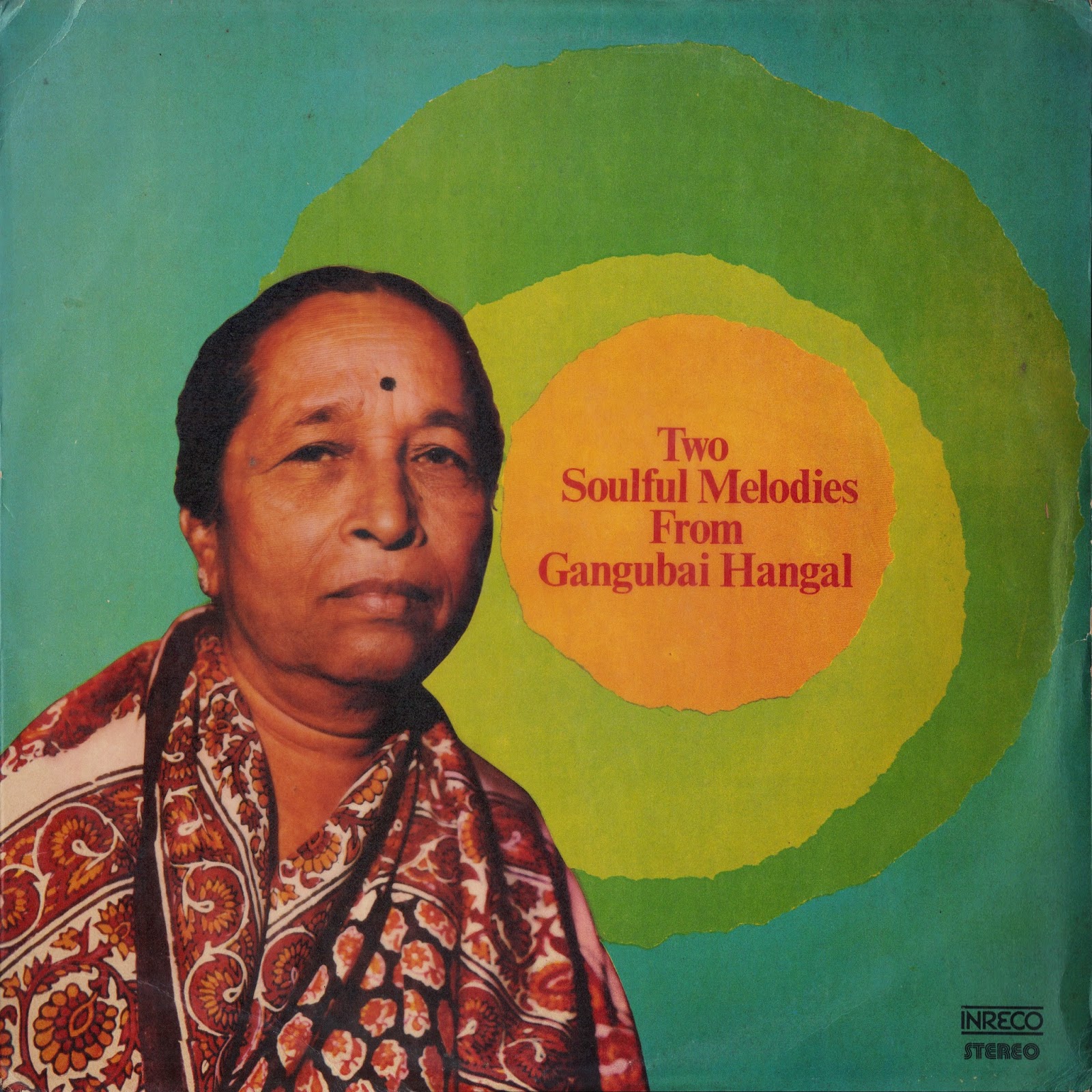
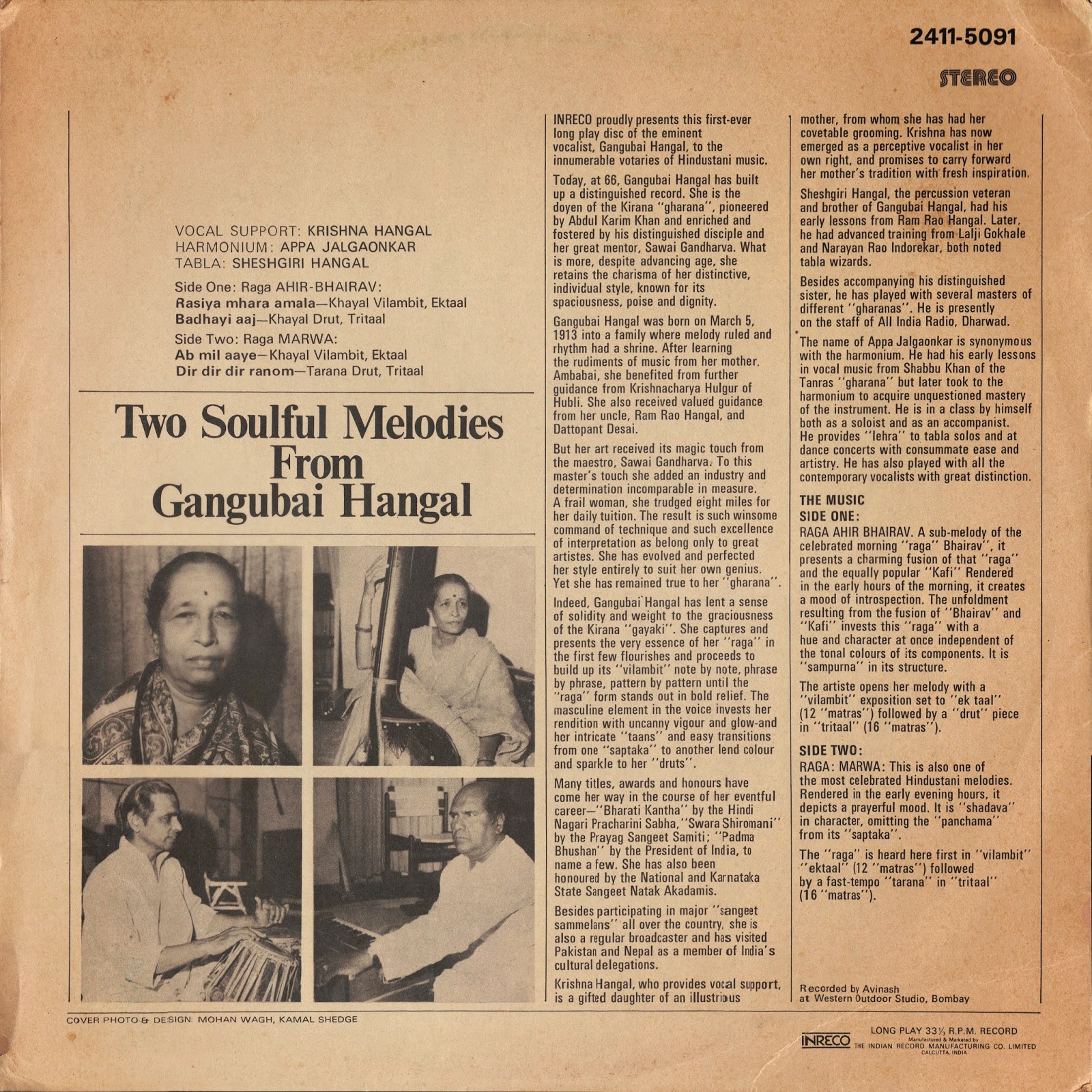
%20-%20front.jpg)
%20-%20back.jpg)
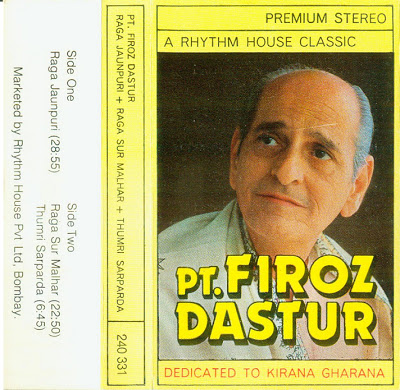
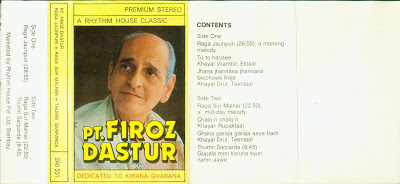
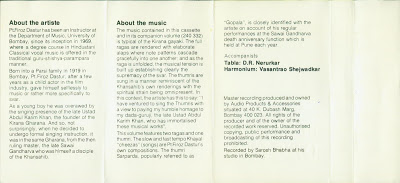
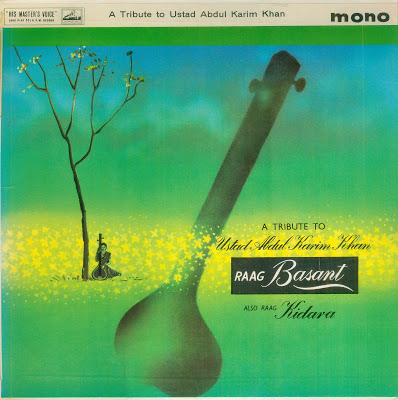
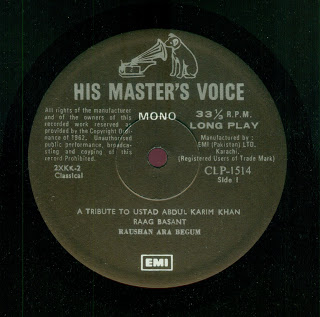
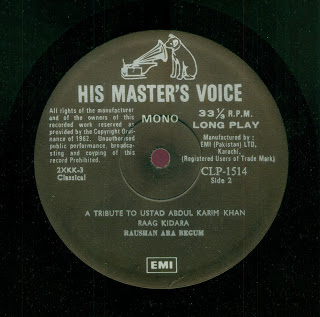
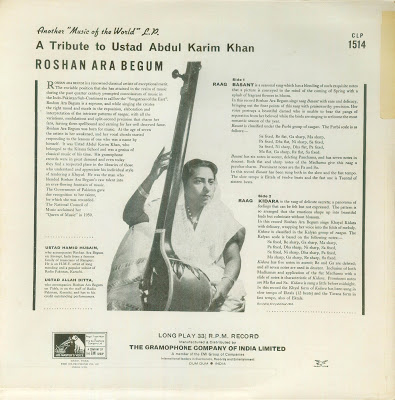
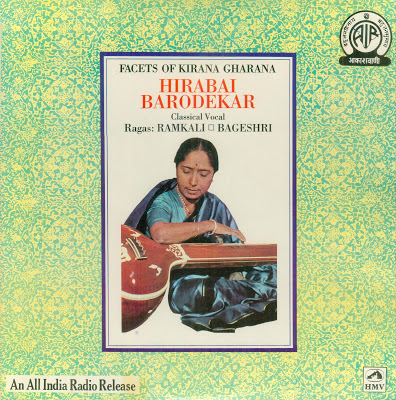
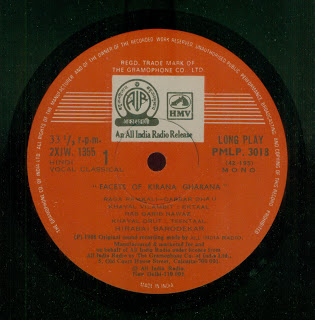
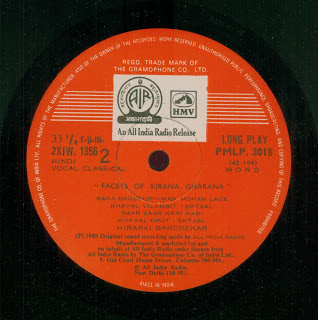
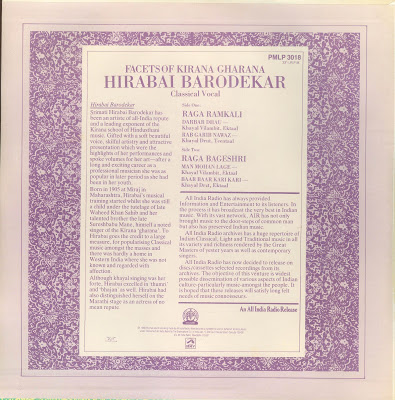
%20-%20front%201.jpg)
%20-%20front%202.jpg)
%20-%20back.jpg)